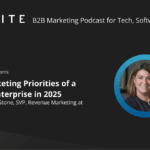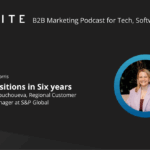September 2022 is the month of our FINITE Ambassador Forums!
What does that mean?
We’ve gathered a cohort of some of our most active and valued FINITE members, who also happen to be experts in various fields of B2B technology marketing! From demand gen, content and messaging to brand marketing and analytics, our Ambassadors know about the latest and fastest-growing trends in the industry.
Ambassador Forums are a chance for FINITE members to connect, share, learn and grow with other passionate marketers, to discuss their current challenges and solve them collaboratively.
At Kartik’s Forum on account-based marketing, he covered the fundamentals of ABM for those who are starting to embark on their ABM journey. We thought it would provide extra value for the FINITE community to whip those all into a handy blog, so that all who missed the session can gain key takeaways.
How do you define ABM?
Account-based marketing has many different definitions but one thing Kartik believes is the common thread is that you start from a named account list. If you have a list of ideal companies you’d like to target, whether that’s due to size, current technologies they use or geography, then you’ve already started doing ABM.
Whether you have 10 target accounts, or 1000, both sizes pose different challenges. 10 accounts increases pressure on an ABM team to ensure those strategies are fruitful, and having 1000 target accounts might mean your approach isn’t very meaningful.
Why should you do ABM?
Still wondering whether ABM is for you? In an abstract sense, ABM changes the way you’re thinking as a marketer. It takes traditional marketing and expands it beyond awareness objectives.
ABM also unlocks conversations within a company. When you’re all aligned on the same accounts, across teams and internally within them, it creates synergy across the entire organisation.
Sales and marketing alignment
ABM also helps with sales and marketing alignment, as an account list provides clear, aligned objectives. Sometimes it works better if ABM is viewed as a sales enablement tool, as in to build momentum with accounts until they seal the deal.
ABM tips and tricks
An ABM programme should be at least the length of your average sales cycle. Or else you won’t have enough time to influence an account and truly see the impact of your efforts.
KPI setting
It’s important with any marketing campaign to manage expectations, not to overpromise, and not to underdeliver.
Setting realistic KPIs is a first step to ensuring you’re on the right track and measuring the value and ROI of your programme. Remember, KPIs shouldn’t be limited to impressions, pipeline and numbers. Success can and indeed should also be measured by looking at deal sizes, pipeline velocity and churn rates.
Tactics to create impactful experiences
Roundtables are a powerful way to gain the attention of the right person at the right time. It’s often better to use a third party to host these and send invites.
Flood accounts with hyper targeted messaging that showcases awareness of their current pain points and how you solve them. This requires a lot of research into the company, its stakeholders and their current ways of working.
Discussing the technology they currently use can be an interesting approach that can justify a cold call or email. Explaining your knowledge of their tech stack, and showing how and why you fit into it, can make an impact.
A big thank you to Kartik for leading the session! To many more fantastic discussions on ABM with FINITE members and B2B tech marketers beyond.










